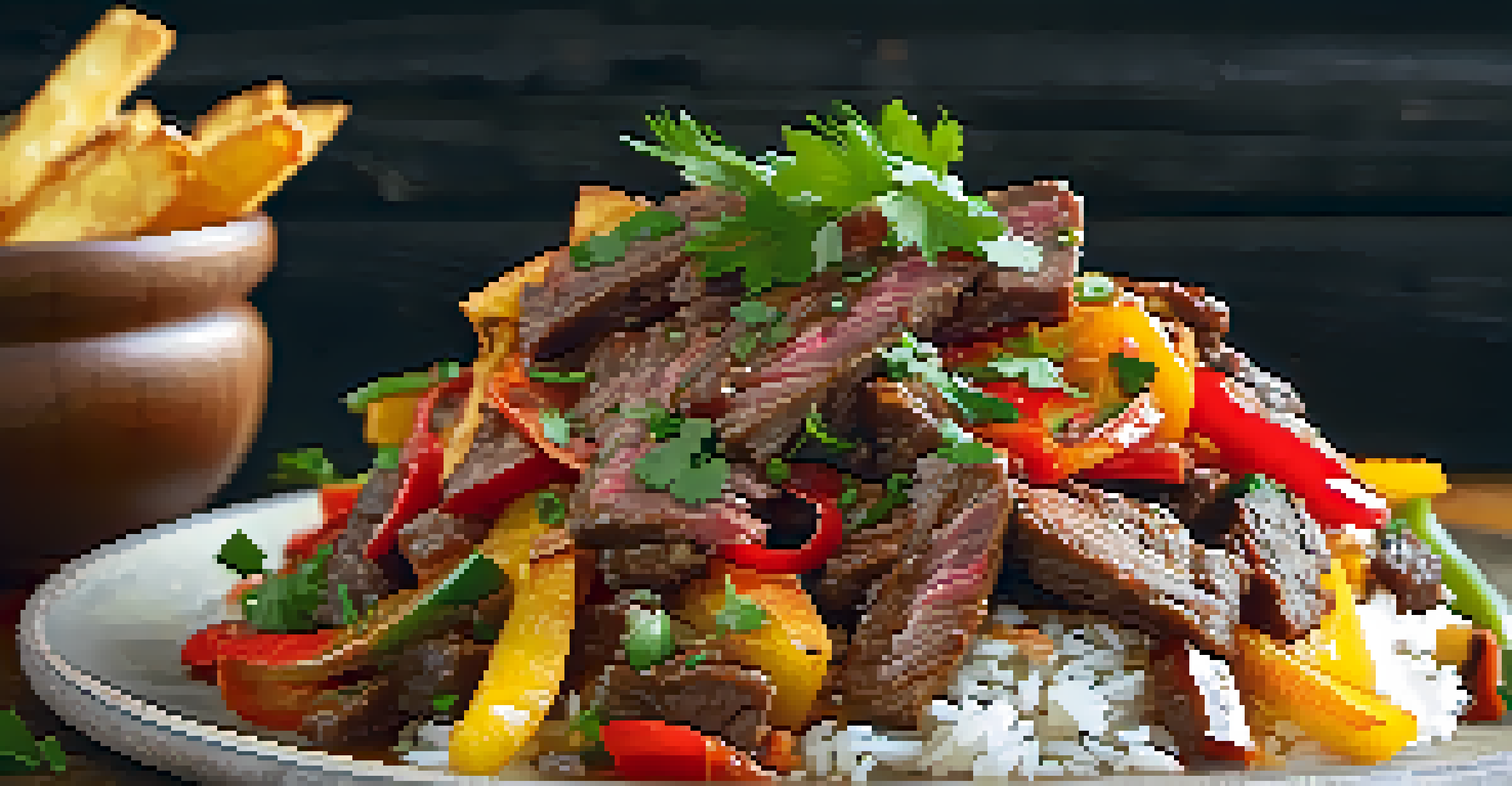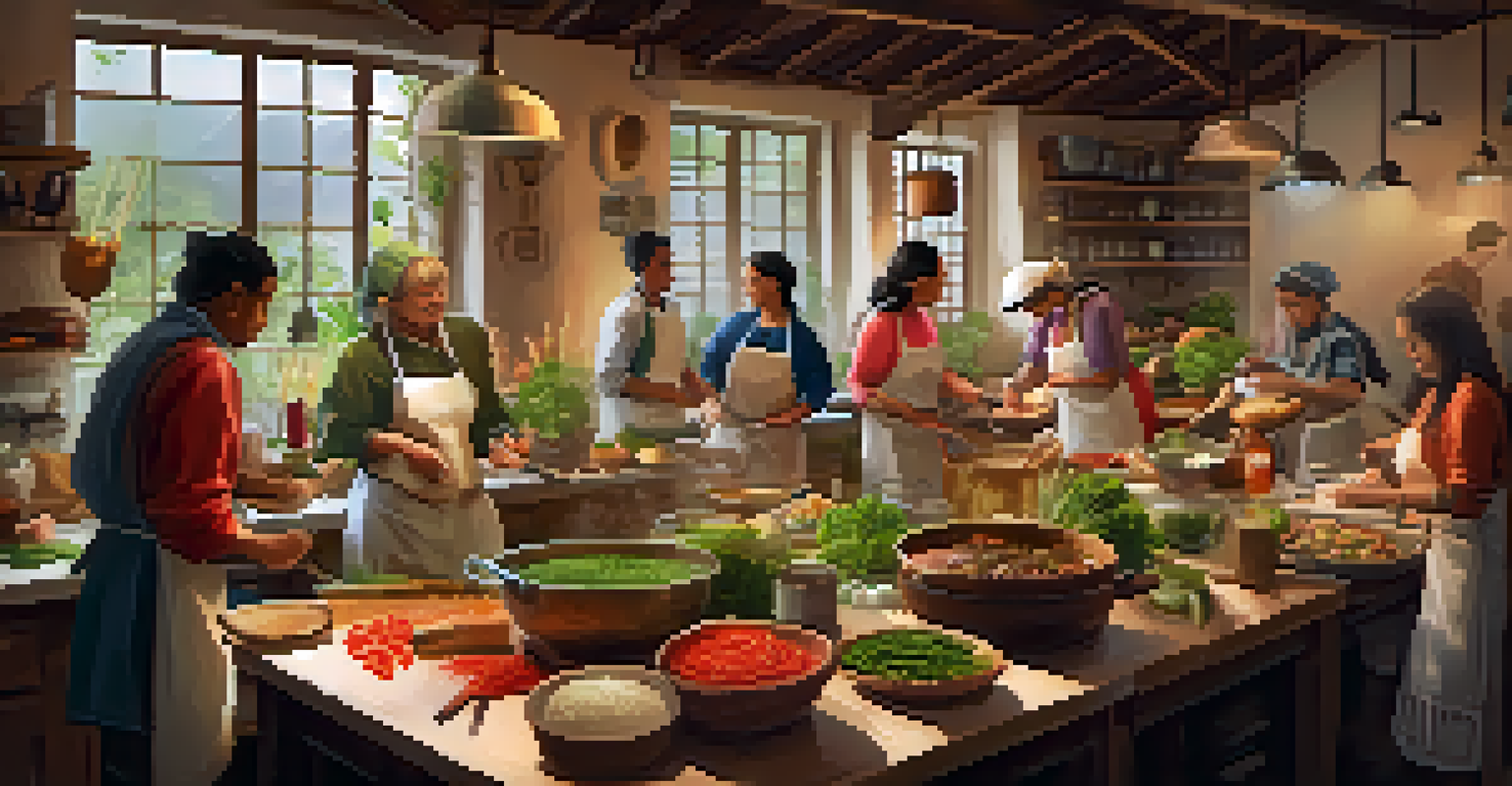Explore Peruvian Culinary Arts: Workshops for Food Lovers

An Introduction to Peru's Rich Culinary Heritage
Peruvian cuisine is a vibrant tapestry woven from diverse cultural influences. With roots in Indigenous, Spanish, African, and Asian traditions, it offers a unique blend of flavors and techniques. This rich culinary heritage is not just about food; it tells the story of Peru's history and its people.
Cooking is like love. It should be entered into with abandon or not at all.
One of the most exciting aspects of Peruvian cuisine is its use of fresh, local ingredients. From the Andean mountains to the coastal regions, Peru offers a bounty of produce, fish, and meats that inspire chefs and home cooks alike. The celebration of these ingredients is evident in every dish, making each meal a delightful experience.
Participating in culinary workshops allows food lovers to dive deeper into this heritage. These hands-on experiences not only teach you how to cook classic dishes but also connect you with the cultural significance behind each ingredient and technique.
Popular Dishes to Explore in Workshops
When you think of Peruvian cuisine, dishes like ceviche and lomo saltado often come to mind. Ceviche, a refreshing dish made from fresh fish marinated in citrus juices, is a staple that showcases the country's coastal resources. Learning to prepare it properly in a workshop is both a culinary and cultural revelation.

Lomo saltado, a stir-fry combining marinated strips of beef with vegetables and spices, reflects the fusion of Chinese and Peruvian cooking styles. Workshops that focus on these iconic dishes provide not just recipes but also insights into the flavors that define Peru's culinary landscape.
Peruvian Cuisine's Cultural Tapestry
Peruvian cuisine is a rich blend of Indigenous, Spanish, African, and Asian influences, showcasing the country's diverse cultural heritage.
Beyond these well-known dishes, workshops often introduce lesser-known gems like ají de gallina, a creamy chicken dish, or causa, a delicious layered potato dish. Each dish tells a story, and cooking them allows participants to become part of that narrative.
The Benefits of Hands-On Culinary Learning
Participating in a culinary workshop is an immersive way to learn not just the 'how' but the 'why' of cooking. When you chop, sauté, and taste alongside expert chefs, you gain practical skills that you can apply in your own kitchen. This hands-on approach makes the learning process both enjoyable and effective.
Food is not just what we eat; it’s a reflection of who we are.
Moreover, these workshops often foster a sense of community. Cooking alongside fellow food lovers creates bonds that extend beyond the kitchen, allowing for shared experiences and stories. It's a wonderful way to meet new friends from around the world who share your passion for food.
Additionally, the interactive environment encourages creativity. You're not just following a recipe; you're encouraged to experiment and adapt, empowering you to develop your personal style in cooking.
Finding the Right Culinary Workshop
With numerous workshops available, choosing the right one can feel daunting. Start by considering your culinary interests—are you drawn to traditional dishes, or do you want to explore contemporary interpretations? Many workshops specialize in specific themes, from street food to fine dining.
Researching reviews and testimonials can also help narrow your options. Hearing firsthand experiences from past participants provides valuable insights into the quality of instruction and overall experience. Don't hesitate to reach out to organizers with questions to ensure a good fit.
Hands-On Learning Enhances Cooking Skills
Participating in culinary workshops allows you to gain practical cooking skills while connecting with others who share your passion for food.
Lastly, consider the location and setting of the workshop. Whether it's in a bustling city kitchen or a serene countryside villa, the atmosphere can greatly enhance your culinary journey.
What to Expect During Your Workshop
Typically, a culinary workshop begins with an introduction to the day's menu and the ingredients. Instructors often share stories about the origins of the dishes and the significance of each ingredient, setting the stage for the cooking experience. This context enriches your understanding and appreciation for the food you'll create.
As the class progresses, participants are guided through each step of the cooking process. You'll learn techniques such as marinating, seasoning, and plating, all while receiving personalized tips from experienced chefs. This guidance ensures that even novice cooks feel confident in their abilities.
Finally, most workshops culminate in a communal meal where everyone shares the fruits of their labor. This shared experience allows you to savor the dishes together, fostering a sense of accomplishment and connection with your fellow food enthusiasts.
The Role of Local Ingredients in Peruvian Cooking
One of the hallmarks of Peruvian cuisine is its commitment to using local, seasonal ingredients. This practice not only supports local farmers but also ensures that dishes are fresh and flavorful. Many workshops emphasize the importance of sourcing ingredients from local markets, allowing participants to appreciate the bounty of Peru.
In these workshops, you'll often learn about unique Peruvian ingredients like aji peppers, quinoa, and native potatoes. Each ingredient brings its own flavor profile and texture, making the culinary experience all the more diverse. Understanding these local components can inspire you to recreate authentic Peruvian dishes at home.
Embracing Local Ingredients Matters
Using fresh, local ingredients in Peruvian cooking not only enhances flavor but also supports sustainability and community.
By embracing local ingredients, participants also gain a deeper appreciation for sustainability and food culture. This focus on fresh produce not only enhances flavor but also reinforces the connection between food, community, and the environment.
Continuing Your Culinary Journey Beyond the Workshop
After completing a culinary workshop, the journey doesn't have to end there. Armed with new skills and recipes, you can continue experimenting in your own kitchen. Consider hosting a Peruvian dinner party to share your newfound knowledge and impress friends with your culinary creations.
Additionally, many participants find inspiration to explore further. This might mean taking additional workshops, experimenting with other cuisines, or even diving into food blogging to document your culinary adventures. The possibilities are endless when you embrace your passion for cooking.

Finally, consider connecting with the culinary community online. Joining forums or social media groups dedicated to Peruvian cuisine can provide ongoing support, inspiration, and even new friendships as you continue your culinary journey.